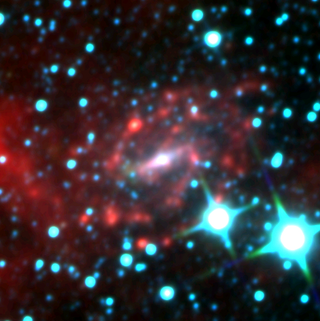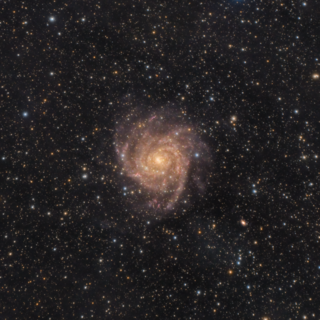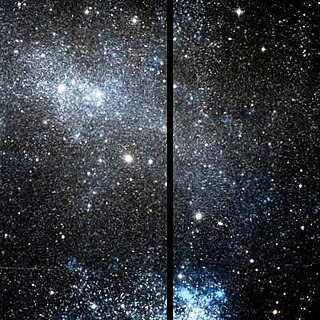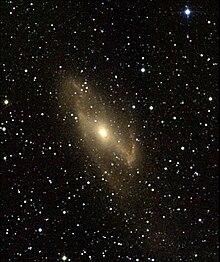
The IC 342/Maffei Group corresponds to one or two galaxy groups close to the Local Group. The member galaxies are mostly concentrated around either IC 342 or Maffei 1, which would be the brightest two galaxies in the group. The group is part of the Virgo Supercluster. However, recent studies have found that the two subgroups are unrelated; while the IC 342 group is the nearest galaxy group to the Milky Way, the Maffei 1 group is several times farther away, and is not gravitationally bound to the IC 342 group.

The Sculptor Group is a loose group of galaxies visible near the south galactic pole. The group is one of the closest groups of galaxies to the Local Group; the distance to the center of the group from the Milky Way is approximately 3.9 Mpc (12.7 Mly).

Messier 83 or M83, also known as the Southern Pinwheel Galaxy and NGC 5236, is a barred spiral galaxy approximately 15 million light-years away in the constellation borders of Hydra and Centaurus. Nicolas-Louis de Lacaille discovered M83 on 23 February 1752 at the Cape of Good Hope. Charles Messier added it to his catalogue of nebulous objects in March 1781.

Centaurus A is a galaxy in the constellation of Centaurus. It was discovered in 1826 by Scottish astronomer James Dunlop from his home in Parramatta, in New South Wales, Australia. There is considerable debate in the literature regarding the galaxy's fundamental properties such as its Hubble type and distance. NGC 5128 is one of the closest radio galaxies to Earth, so its active galactic nucleus has been extensively studied by professional astronomers. The galaxy is also the fifth-brightest in the sky, making it an ideal amateur astronomy target. It is only visible from the southern hemisphere and low northern latitudes.

Dwingeloo 1 is a barred spiral galaxy about 10 million light-years away from the Earth, in the constellation Cassiopeia. It lies in the Zone of Avoidance and is heavily obscured by the Milky Way. The size and mass of Dwingeloo 1 are comparable to those of Triangulum Galaxy.
Dwingeloo 2 is a small irregular galaxy discovered in 1996 and located about 10 million light-years away from the Earth. Its discovery was a result of the Dwingeloo Obscured Galaxy Survey (DOGS) of the Zone of Avoidance using the Dwingeloo Radio Observatory. Dwingeloo 2 is a companion galaxy of Dwingeloo 1.

Messier 94 is a spiral galaxy in the mid-northern constellation Canes Venatici. It was discovered by Pierre Méchain in 1781, and catalogued by Charles Messier two days later. Although some references describe M94 as a barred spiral galaxy, the "bar" structure appears to be more oval-shaped. The galaxy has two ring structures.

Messier 95, also known as M95 or NGC 3351, is a barred spiral galaxy about 33 million light-years away in the zodiac constellation Leo. It was discovered by Pierre Méchain in 1781, and catalogued by compatriot Charles Messier four days later. In 2012 its most recent supernova was discovered.

Messier 96 is an intermediate spiral galaxy about 31 million light-years away in the constellation Leo.

IC 342 is an intermediate spiral galaxy in the constellation Camelopardalis, located relatively close to the Milky Way. Despite its size and actual brightness, its location behind dusty areas near the galactic equator makes it difficult to observe, leading to the nickname "The Hidden Galaxy", though it can readily be detected even with binoculars. If the galaxy were not obscured, it would be visible by naked eye. The dust makes it difficult to determine its precise distance; modern estimates range from about 7 mega light-years (Mly) to about 11 Mly. The galaxy was discovered by William Frederick Denning in 1892. It is one of the brightest in the IC 342/Maffei Group, one of the closest galaxy groups to the Local Group. Edwin Hubble first thought it to be in the Local Group, but it was later determined not to be a member.

NGC 4945 (also known as Caldwell 83) is a barred spiral galaxy in the constellation Centaurus, visible near the star Xi Centauri. The galaxy was discovered by James Dunlop in 1826 and is thought to be similar to the Milky Way Galaxy, although X-ray observations show that NGC 4945 has an unusual energetic Seyfert 2 nucleus that might house a supermassive black hole. Around the nucleus of the galaxy, there is a dense disk of dust and gas, along with many dense star clusters. This object has an estimated mass of 1.4+1.4
−0.7×1011 M☉.
The M94 Group is a loose, extended group of galaxies located about 13 million light-years away in the constellations Canes Venatici and Coma Berenices. The group is one of many groups that lies within the Virgo Supercluster and one of the closest groups to the Local Group.

NGC 5408 is an irregular galaxy in the constellation Centaurus. It was discovered by John Herschel on June 5, 1834.

NGC 3384 is an elliptical galaxy in the constellation Leo. The galaxy was discovered by William Herschel in 1784 as part of the Herschel 400 Catalogue. The high age of the stars in the central region of NGC 3384 was confirmed after analysis of their color. More than 80% were found to be Population II stars which are over a billion years old. The supermassive black hole at the core has a mass of 1.6+0.1
−0.2×107 M☉.

UGCA 86 is a Magellanic spiral galaxy. It was first thought to be part of the Local Group, but after the brightest stars in the galaxy were observed, it became clear that it was located in the IC 342/Maffei Group. UGCA 86 is thought to be a satellite galaxy of IC 342, however the separation between the two galaxies is over 50% larger than the distance between the Milky Way and the Magellanic Clouds.

NGC 247 is an intermediate spiral galaxy about 11.1 Mly away in the constellation Cetus. This distance was confirmed in late February 2011. Previous measurements showed that the galaxy was about 12.2 Mly away, but this was proved to be wrong. NGC 247 is a member of the Sculptor Group, and is 70 000 light years in diameter.

NGC 4236 is a barred spiral galaxy located in the constellation Draco.

NGC 4449, also known as Caldwell 21, is an irregular Magellanic type galaxy in the constellation Canes Venatici, being located about 13 million light-years away. It is part of the M94 Group or Canes Venatici I Group that is relatively close to the Local Group hosting our Milky Way galaxy.

Maffei 1 is a massive elliptical galaxy in the constellation Cassiopeia. Once believed to be a member of the Local Group of galaxies, it is now known to belong to a separate group, the IC 342/Maffei Group. It was named after Paolo Maffei, who discovered it and the neighboring Maffei 2 in 1967 via their infrared emissions.
MB3 is a dwarf spheroidal galaxy discovered in 1997 and located about 10 million light-years away from the Earth. It was discovered during an optical survey of the IC 342/Maffei group to which the galaxy is a member. MB3 is a companion galaxy of Dwingeloo 1 and situated in the Zone of Avoidance. MB 3 is thought to be a member of the IC 342/Maffei Group, a galaxy group adjacent to the Local Group.
















